#Danish Soldiers
Explore tagged Tumblr posts
Text
youtube
#youtube#militarytraining#Germany#Fitness#Exercise#Military#Army#Training#Danish Soldiers#Danish Army#Danish Military#Strength#Military Training#Danish Soldiers Training#Soldiers#Training Camp#Soldier Training#Military Fitness.#Firm Stallion Exercise#Combat Training#Military Exercise#Physical Training
0 notes
Text
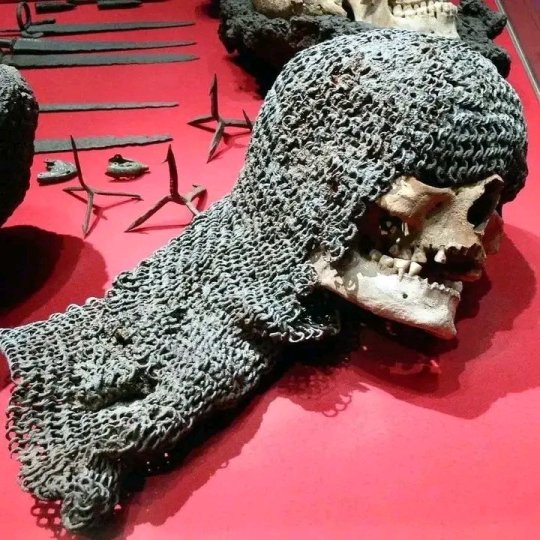
The skull of a soldier who was buried with his armor in the bloody war between the forces of the Danish king and the Yeomen, the people of Gotland, in 1361, near the historic city of Visby, in present-day Sweden.
📷unknown
114 notes
·
View notes
Text

Boardwalk Empire S01E07 (Home)
Book title: The Tin Soldier (Den standhaftige tinsoldat in Danish; 1838) by Hans Christian Andersen
Submitted by @colorhollywood
#boardwalk empire#boardwalk empire season 1#michael pitt#home#books in tv shows#the tin soldier#hans christian andersen#danish literature
16 notes
·
View notes
Text

Travel poster for Copenhagen, Denmark featuring the Royal Guards marching past the Rundetaarn (c. 1930).
#vintage poster#vintage travel poster#1930s#copenhagen#Rundetaarn#denmark#royal guard#soldiers#danish#travel#tourism#holiday
100 notes
·
View notes
Photo
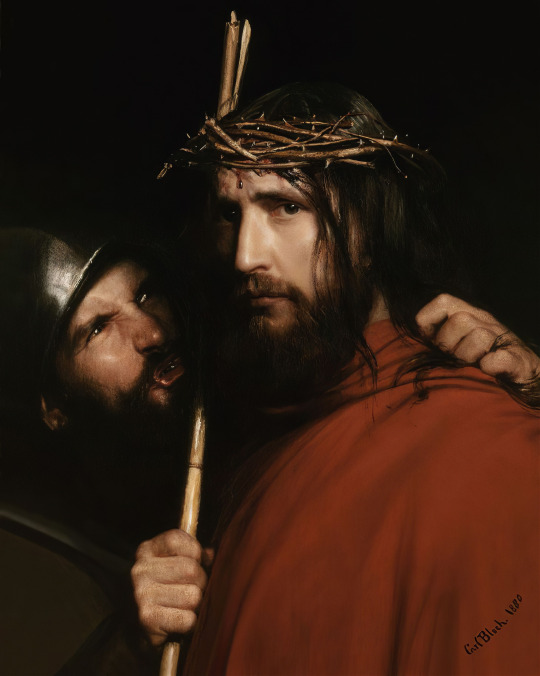
Carl Bloch (Danish, 1834 - 1890) Christ with Mocking Soldier, 1880
#Carl Bloch#danish art#christ with mocking soldier#danish#denmark#classical art#fine art#fine arts#oil painting#jesus#jesus christ#christianity#christentum#Christendom#europe#european art#europa#european#art#traditional art#christian art#christian#catholic#catholicism#roman catholic#beautiful art
335 notes
·
View notes
Text

Ditmarskertoget | The Attack on Dithmarschen by Rasmus Christiansen
The Danish king John (Hans) invaded the autonomous peasant's republic of Dithmarschen in 1500. The attack failed, and the king narrowly escaped the battle.
#battle of hemmingstedt#art#rasmus christiansen#denmark#kalmar union#danish#dithmarschen#history#europe#european#northern europe#scandinavia#medieval#middle ages#knights#battle#armour#combat#troops#soldiers#king john of denmark#peasants
128 notes
·
View notes
Text






#boys don't cry#boys don't cry 1999#soldier's girl#soldier's girl 2003#the danish girl#hilary swank#brandon teena#lee pace#calpernia addams#eddie redmayne#lili elbe#transgender
41 notes
·
View notes
Text

Beefeater guards
Copenhagen, Denmark
#denmark#copenhagen#beefeater#guard#soldier#danish#uniform#travel#vacation#tourist#film#analog#filmisnotdead#ishootfilm#35mm#nikon fm3a#fujicolor 400#nikon 50mm 1.4 ais#rifle#royalty
7 notes
·
View notes
Text


Jørgen V. Sonne, The Morning After the Battle of Isted 25 July 1850, 1876, Statens Museum for Kunst, open.smk.dk, public domain.
(Picture source for The Morning After the Battle of Isted 25 July 1850)
#love how one of the soldiers is sleeping leant on his horse#Jørgen Valentin Sonne #Jørgen Sonne#Jørgen V. Sonne#art#horses#art history#horse#horse art#military#cavalry#Danish art#danish artist#danish painting#1800's art#19th century art#morning#smk
70 notes
·
View notes
Text
Fairytales
I kind of noticed a big misunderstanding of German fairytales.
There are two kinds of fairytales.
The folk fairytale:
This are your classic fairytales, born from a thousand years of oral history. Most of the Brother Grimm's fairytales are folk fairytales. Folk fairytales end well for the Heros and terrible for the villains (example: snow white- the evil queen is forced to dance in hot iron shoes till she dies, in snow whites Wedding)
It plays in an unknown land and in an unknown time. (starting phrase of fairytales in German : For langer, langer Zeit, in einem weiteren entfernten Land [A long, long time ago, in a far away land]) and features stereotypical characters like 'big bad wolf' and 'beatiful princess'.
It often uses magical numbers like...
7 (seven dwarves behind seven mountains, 7 ravens, seven flys killed' at once, seven Kids(?)/ little goats)
3 (three taskes, three ways to kill Snow White, three Balls in 'Aschenputtel' (German Cinderella))(examples for this are a little hard to explain in few words because they're so specific)
13 (thirteen fairies in sleeping beauty)
These stories are often uses to explain morals or rules of survival. (Don't abuse your Kids/ step Kids, don't just Run into the woods, don't let strangers into the House)
The Art fairytale:
This fairytales was written by an author and is Not meant to explain a rule or bring hope.
Most of these are very tragic. The little Mermaid (from Hans Christian Andersen) would be a good example.
Others would be 'The Steadfast Tin Soldier'(also from Hans Christian Andersen) or the 'girl with the matches' (ALSO from Hans Christian Andersen)(goodnes he wrote a lot of these, this poor man's mental health really was bad)(Spoiler: the solider and the girl die)
Hans Christian Andersen wrote 156 Art fairytales. Remember: they all endet badly! I think the guy set in Stone what an Art fairytales is?!? I did Not know that? I Just wanted to teach about fairytales, I did NOT want to learn about this man's tragic live.
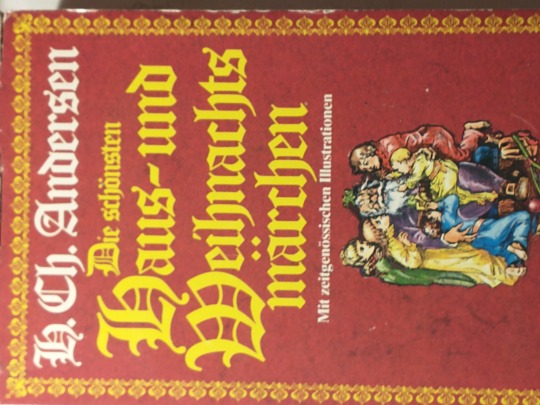
Like this are two books, full of fairytales (mostly Art fairytales) from the guy.

TWO books.
And the title reads ' Die schönsten Haus- und Weihnachtsmärchen' (The Most beautiful home and Christmas fairytales)
Beautiful fairytales my ass. The guy kust did therapy but as written stories. I mean, he wrote Snow Queen, which kind of ends well? But that doesn't really make it better.
So before I end this, to mull over Hans mental health:
Fairytales are not the only type of German folk Story. They are a very specific Type, that follows specific rules. Other types follows other rules.
Not every German folk Story ist a fairytale. And other very old Stories can end badly, but then it's not a fairytale. Not a folk one at least. But maybe it's danish and actually from this depressed Gay Poet that seems to have written all the Art fairytales of my childhood. Further more, there are many folk fairytales that do not come from Germany, but those also follow These rules more or less. (There are also a lot of different versions of the same fairytale all over Europe)
#Fairytales#Hans Christian Andersen#the little mermaid#snow queen#snow white#sleeping beauty#dornröschen#schneewittchen#Gebrüder Grimm#brothers grimm#The Steadfast Tin Soldier#The girl with the matches#Der standhafte Zinnsoldat#Das Mädchen mit den Schwefelhölzern#Die kleine Meerjungfrau#german fairytales#danish fairytales#send Help for this depressed#gay poet#Trying to explain fairytales while Not getting depressed because history#Die Märchen der Gebrüder Grimm
7 notes
·
View notes
Text

This bad boy can hold so much nationalistic propaganda about how evil Swedish people are
#me: oh cool a folklore collection i haven't read!#30 pages in a row: here's all the intricate details of how swedish soldiers tortured random farmers#but also look how brave our Honorable Danish Men were for fighting back
2 notes
·
View notes
Text
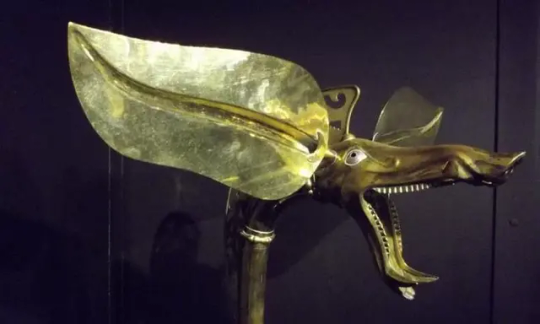

The 'Carnyx' Nightmare of the Roman Soldiers
The Carnyx was a brass musical instrument used as a psychological weapon of war by the ancient Celts between 300 BC and 200AD in western and central Europe and beyond.
The carnyx was once widespread throughout much of Europe, although only a dozen or so fragments are known to us.
It was carried by bands of Celtic mercenaries; it was present at the attack on the Greek sanctuary at Delphi in 279 BC; it defied Julius Caesar in Gaul; and it faced Claudius when he invaded Britain. They are even shown on a Buddhist sculpture in India, proof of the far-flung connections of the Iron Age world.
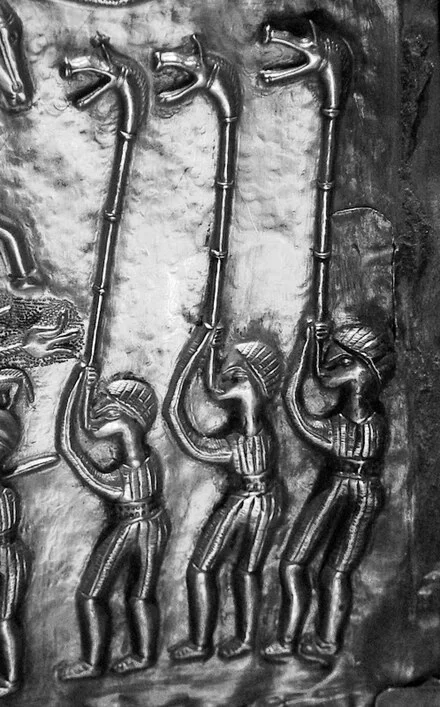
However, they were not only used by the Celts; they were also used by the Dacians in modern Romania. The term “Celtic” is a complicated one. The concept of a pan-European Celtic culture is a myth; rather, aspects of art and technology were shared across vast distances by diverse cultures. The carnyx was one example of this.
A 12-foot-long, thin bronze tube with right-angle bends on both ends made up the carnyx. The lower end ended in a mouthpiece, and the upper end flared out into a bell that was usually decorated to look like a wild boar’s had. Historians believe it had a tongue that flapped up and down, increasing the noise made by the instrument. The carnyx was played upright so that the boar’s head bell protruded well above the warriors’ heads. Its primary goal was to create more noise and confusion on the battlefield.
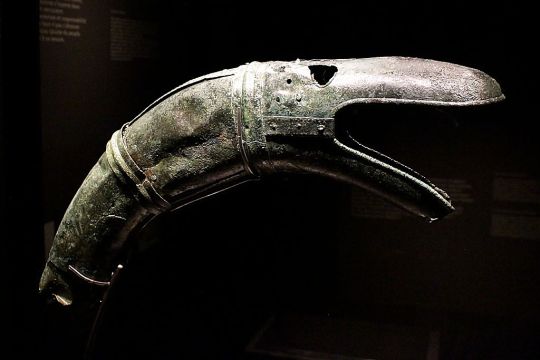
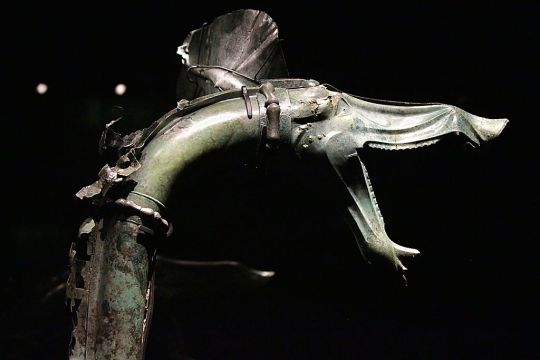
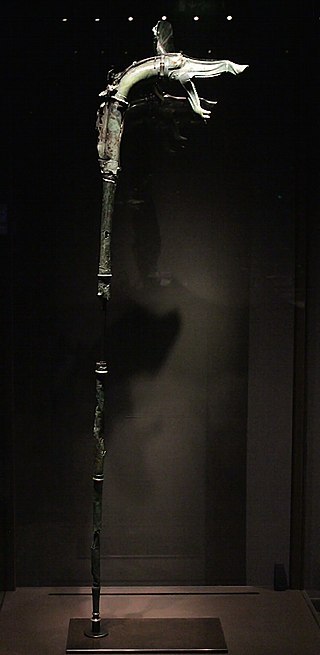
The Greek historian Polybius (206-126BC) was so impressed by the clamor of the Gallic army and the sound of the carnyx, he observed that “there were countless trumpeters and horn blowers and since the whole army was shouting its war cries at the same time there was such a confused sound that the noise seemed to come not only from the trumpeters and the soldiers but also from the countryside which was joining in the echo”.
And the Roman historian Diodorus Siculus wrote, “Their trumpets are also of a peculiar and barbaric kind which produce a harsh, reverberating sound suitable to the confusion of battle.”
Archaeologists discovered a hoard of ritually destroyed weapons in 2004, including a dozen swords, scabbards, spearheads, a shield, bronze helmets, an iron helmet shaped like a swan, a cauldron, animal remains, and seven carnyces. Before the Tintignac discovery, the remains of only five actual carnyces had been found.
The finest was unearthed in Deskford, Scotland in 1816. The Deskford carnyx only has the boar’s head bell and is missing the mane, tongue, and tubing. Images of Carnyx players have been found as well. A Roman denarius, dating from 48 BC bears a representation of a Carnyx. Three carnyx players are featured prominently on the Gundestrup Cauldron, which was found in a Danish peat bog.
One of the seven found at Tintignac, on the other hand, was almost entirely complete. The Tintignac Carnyx was broken into 40 pieces. When puzzled back together, it was found to be just an inch short of six feet long with a single missing section of the tube. The bell was a boar’s head with protruding tusks and large pointed ears. Once restored, the Tintignac Carnyx proved to be the first virtually complete carnyx ever found.
By Leman Altuntaş.
Music video by John Kenny.
#The Carnyx#The 'Carnyx' Nightmare of the Roman Soldiers#Iron Age war trumpet#ancient artifacts#archeology#archeolgst#history#history news#ancient culture#ancient civilizations#celtic mythology#celtic history#roman history#roman empire#roman legion
3K notes
·
View notes
Text

So I got this tag on my answer to an ask about when it became acceptable for western women to wear pants, and you know it's all I need to go on a tangent.
I think the short answer here would be men have worn skirts as long as people have worn anything, so pretty long tbh. But since I am incapable of answering anything shortly, I think we can re-frame this question:
When did skirts stop being socially acceptable for men?
So let's start with acknowledging that tunics, togas, kirtles and such men wore through history were, in fact, skirts. I think there's often a tendency to think of these as very different garments from those that women wore, but really they are not. Most of the time they were literally referred to with the same name. (I will do a very broad and simplified overview of men's clothing from ancient times to Early Middle Ages so we can get to the point which is Late Middle Ages.)
Ancient Greek men and women both wore chitons. Even it's length wasn't determined by gender, but by occupation. Athletes, soldiers and slaves wore knee-length chitons for easier movement. Roman men and women wore very similar garment, tunics. Especially in earlier ancient Rome long sleeves were associated with women, but later became more popular and unconventional for men too. Length though was still dependent on occupation and class, not gender. Toga was sure men's clothing, but worn over tunic. It was wrapped around the waist, like a dress would, and then hung over shoulder. Romans did wear leggings when they needed to. For example for leg protection when hunting as in this mosaic from 4th century. They would have been mostly used by men since men would be doing the kinds of activities that would require them. But that does not lessen the dressyness of the tunics worn here. If a woman today wears leggings under her skirt, the skirt doesn't suddenly become not a skirt.
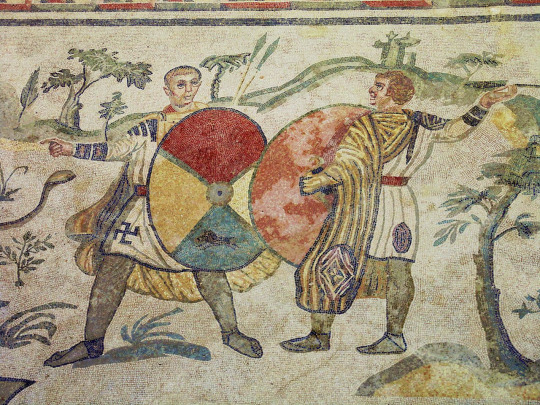
All over Europe thorough the early Middle Ages, the clothes were very similar in their basic shape and construction as in Rome and Greece. In Central and Northern Europe though people would wear pants under shorter tunics. There were exceptions to the everyone wearing a tunic trend. Celtic men wore braccae, which were pants, and short tunics and literally just shirts. Celts are the rare case, where I think we can say that men didn't wear dresses. Most other peoples in these colder areas wore at least knee-length tunics. Shorter tunics and trousers were worn again mostly by soldiers and slaves, so rarely any other woman than slave women. The trousers were though definitely trousers in Early Middle Ages. They were usually loose for easier construction and therefore not that similar to Roman leggings. However leggings style fitted pants were still used, especially by nobility. I'd say the loose trousers are a gray area. They wore both dresses and pants, but still definitely dresses. I'd say this style was very comparable to the 2000s miniskirts over jeans style. First one below is a reconstruction of Old Norse clothing by Danish history museum. The second is some celebrity from 2005. I see no difference.
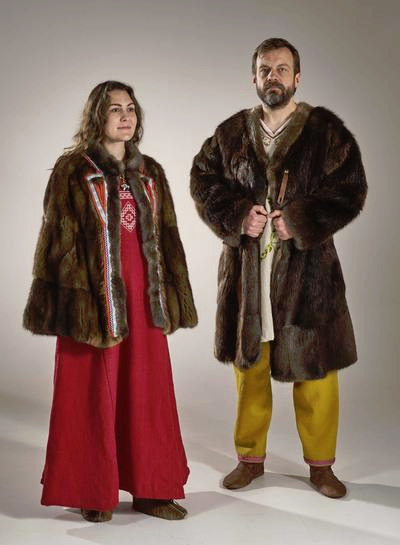

When we get to the high Middle Ages tunics are still used by both men and women, and still it's length is dependent on class and activity more than gender, but there's some new developments too. Pants and skirt combo is fully out and leggings' are back in in form of hose. Hose were not in fact pants and calling them leggings is also misleading. Really they are socks. Or at least that's how they started. As it has become a trend here they were used by everyone, not just men. During early Middle Ages they were worn often with the trousers, sometimes the trousers tucked inside them making them baggy. In high Middle Ages they became very long when used with shorter tunics, fully displacing the need for trousers. They would be tied to the waist to keep them up, as they were not knitted (knitting was being invented in Egypt around this time, and some knitting was introduced to Europe during middle Ages, but it really only took off much later during Renaissance Era) and therefore not stretchy. First picture is an example of that from 1440s. Another exciting development in the High Medieval era was bliaut in France and it's sphere of influence. Bliaut was an early attempt in Europe of a fitted dress. And again used by both men and women. The second illustration below from mid 12th century shows a noble man wearing a bliaut and nicely showing off his leg covered in fitted hose. Bliaut was usually likely fitted with lacing on the sides, but it wasn't tailored (tailoring wasn't really a thing just yet) and so created a wrinkled effect around the torso.
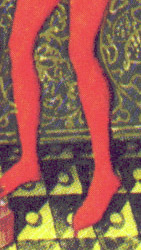

In the 14th century things really picked up in European fashion. European kingdoms finally started to become richer and the rich started to have some extra money to put into clothing, so new trends started to pop up rapidly. Tailoring became a thing and clothes could be now cut to be very fitted, which gave birth to fitted kirtle. At the same time having extra money meant being able to spend extra money on more fabric and to create very voluminous clothing, which gave birth to the houppelande.
Kirtle was once again worn by everyone. It wasn't an undergarment, for women that would be shift and men shirt and breeches, but it was an underlayer. It could be worn in public but often had at least another layer on top of it. The bodice part, including sleeves were very fitted with lacing or buttons (though there were over-layer kirtles that had different sleeves that changed with fashions and would be usually worn over a fitted kirtle). Men's kirtles were short, earlier in 14th century knee-length but towards the end of the century even shorter styles became fashionable in some areas. First picture below shows a man with knee-length kirtle from 1450s Italy.
Houppelande was also unisex. It was a loose full-length overgown with a lot of fabric that was gathered on the neckline and could be worn belted or unbelted. The sleeves were also wide and became increasingly wider (for men and women) later in the century and into the next century. Shorter gowns similar in style and construction to the houppelande were also fashionable for men. Both of these styles are seen in the second picture below from late 14th century.
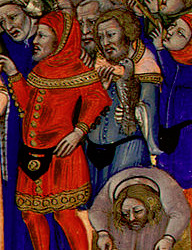

In the very end of 14th century, first signs of pantification of men can be seen. In France and it's sphere of influence the skirt part of the kirtle became so short it barely covered the breeches as seen below on these fashionable musicians from 1395-1400 France. Long houppelandes, length ranging from floor to calf, were still used by men though (the second picture, 1414 France), as were knee and thigh length gowns of similar loose style.
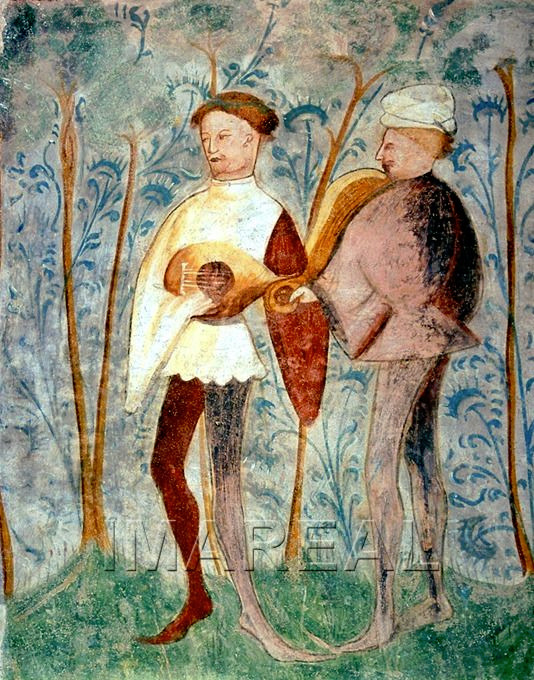
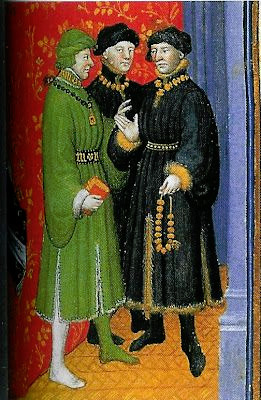
The hems continued to be short through the 15th century in France, but in other places like Italy and German sphere of influence, they were still fairly long, at least to mid thigh, through the first half of the century. In France at some point in late 13th century the very short under-kirtle started to be called doublet and they are just getting shorter in 1400s. The showing underwear problem was fixed by joined hose and the codpiece, signaling the entrance of The Sluttiest Era of men's fashion. Below is an example from 1450s Belgium of doublet and early codpiece in display. As you can see from the other figures, the overgowns of the previous century were also getting very, very short. In the next French example below from 1470s we can see the skirt shrink out of existence right before our eyes.
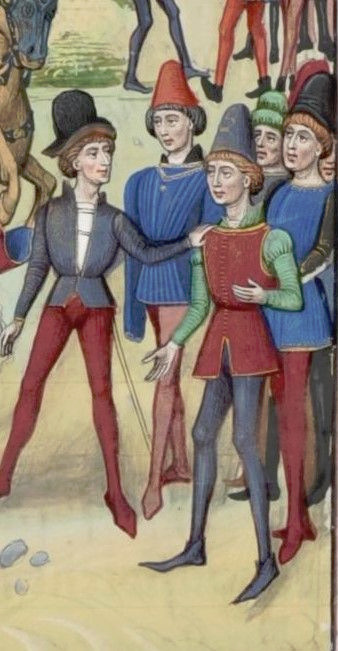
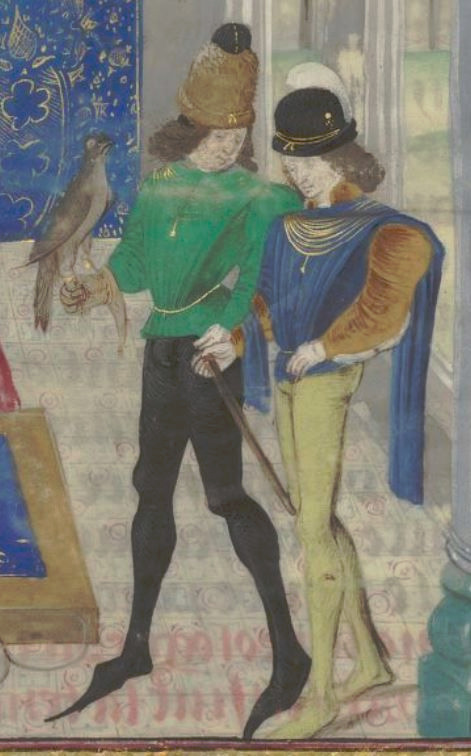
The very skimpy doublet and it's accompanying codpiece spread to the rest of the Europe in the second half of 15th century and it would only get sluttier from there. The Italians were just showing their full ass (example from 1490s). The dress was not gone yet though. The doublet and codpiece continued to be fashionable, but the overdress got longer again in the French area too. For example in the second example there's Italian soldiers in a knee length dresses from 1513.

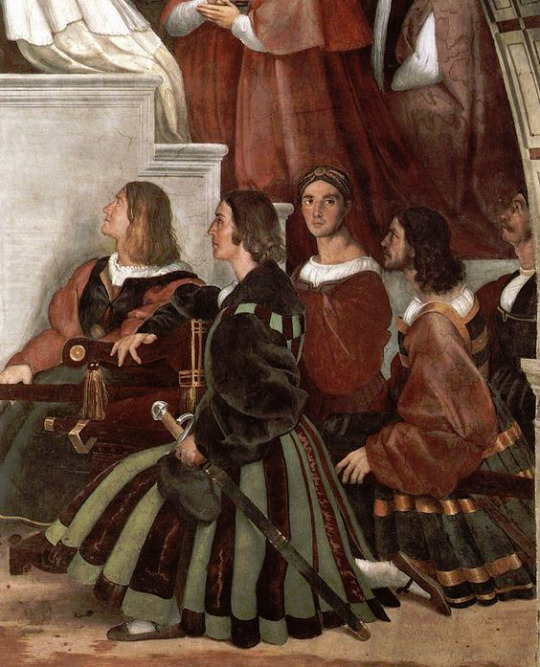
But we have to talk about the Germans. They went absolutely mad with the whole doublet and codpiece. Just look at this 1513 painting below (first one). But they did not only do it sluttier than everyone else, they also changed the course of men's fashion.
Let's take a detour talking about the Landsknecht, the mercenary pikeman army of the Holy Roman Empire. (I'm not that knowledgeable in war history so take my war history explanation with a grain of salt.) Pikemen had recently become a formidable counter-unit against cavalry, which earlier in the Medieval Era had been the most important units. Knights were the professional highly trained cavalry, which the whole feudal system leaned against. On the other hand land units were usually not made of professional soldiers. Landsknecht were formed in late 15th century as a professional army of pikemen. They were skilled and highly organized, and quickly became a decisive force in European wars. Their military significance gave them a lot of power in the Holy Roman Empire, some were even given knighthood, which previously wasn't possible for land units, and interestingly for us they were exempt from sumptuary laws. Sumptuary laws controlled who could wear what. As the bourgeois became richer in Europe in late Middle Ages and Renaissance Era, laws were enacted to limit certain fabrics, colors and styles from those outside nobility, to uphold the hierarchy between rich bourgeois and the nobles. The Landsknecht, who were well payed mercenaries (they would mutiny, if they didn't get payed enough), went immediately absolute mad with the power to bypass sumptuary laws. Crimes against fashion (affectionate) were committed. What do you do, when you have extra money and one of your privileges is to wear every color and fabric? You wear every color and fabric. At the same time. You wear them on top of each other and so they can be seen at the same time, you slash the outer layer. In the second image you can feast your eyes on the Landsknecht.

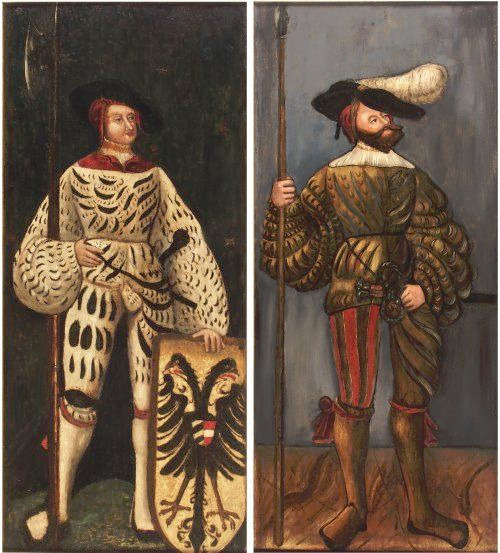
Just to give you a little more of that good stuff, here's a selection of some of my favorite Landsknecht illustrations. This is the peak male performance. Look at those codpieces. Look at those bare legs. The tiny shorts. And savor them.
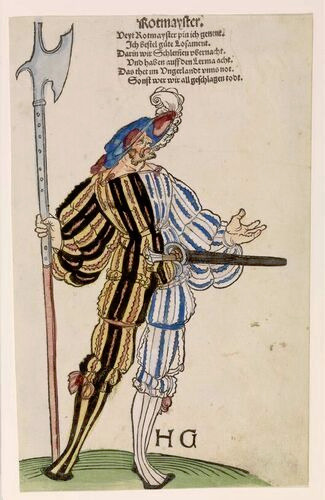
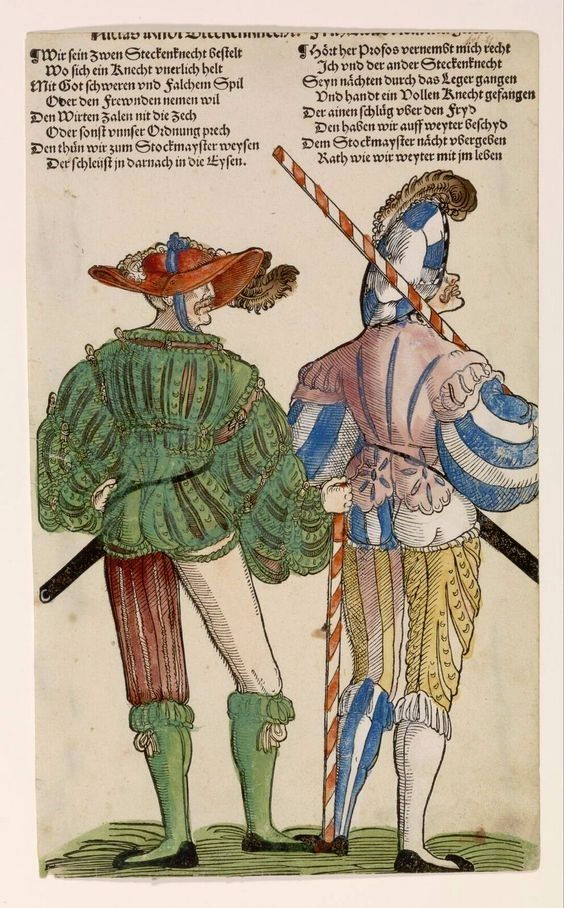
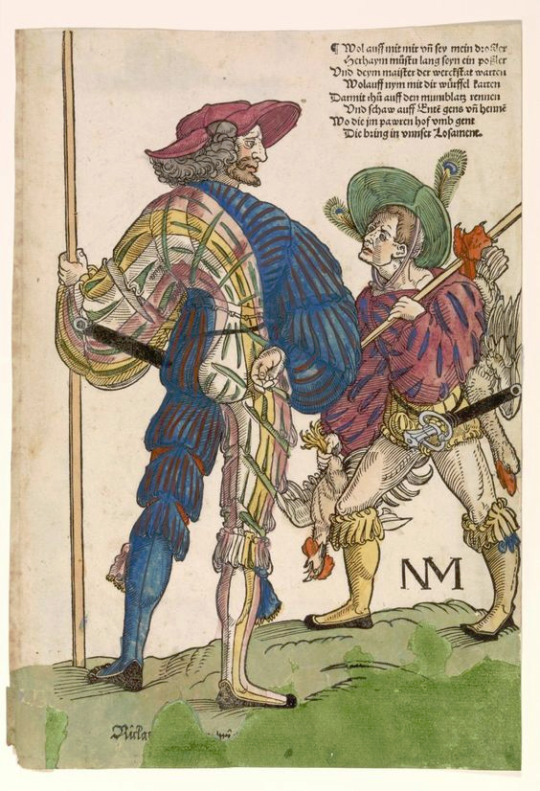
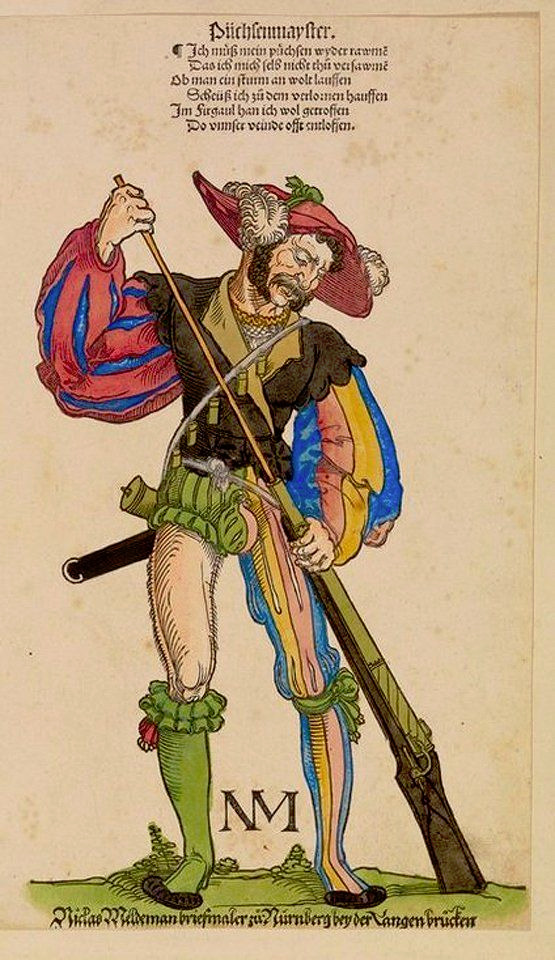
The Landsknecht were the hot shit. Their lavish and over the top influence quickly took over men's fashion in Germany in early 1500s. Slashing, the technique possibly started by them, but at least popularized by them, instantly spread all over Europe. That's how you get the typical Renaissance poof sleeves. They at first slashed the thighs of their hose, but it seems like to fit more of everything into their outfits, they started wearing the hose in two parts, upper hose and nether hose, which was a sort of return to the early Medieval trousers and knee-high hose style. The two part hose was adopted by the wider German men's fashion early in the century, but already in 1520s had spread to rest of Europe. It was first combined with the knee-length overdress that had made it's comeback in the turn of the century, like in this Italian painting from 1526 (first image). At this point knitting had become established and wide-spread craft in Europe and the stockings were born, replacing nether hose. They were basically nether hose, but from knitted fabric. The gown shortened again and turned into more of a jacket as the trunk hose became increasingly the centerpiece of the outfit, until in 1560s doublet - trunk hose combination emerged as the standard outerwear (as seen in the second example, 1569 Netherlands) putting the last nail on the coffin of the men's dress as well as the Sluttiest Era. The hose and doublet became profoundly un-slutty and un-horny, especially when the solemn Spanish influence spread all over with it's dark and muted colors.

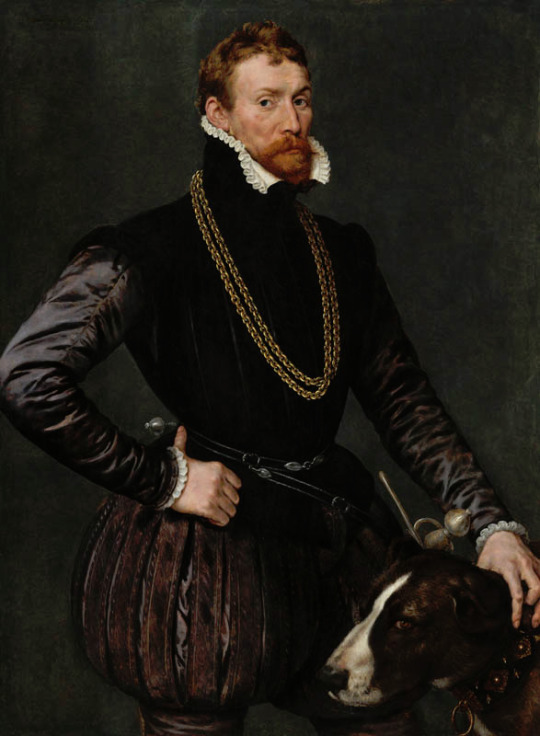
Especially in Middle Ages, but thorough European history, trousers have been associated with soldiers. The largely accepted theory is that trousers were invented for horse riding, but in climates with cold winters, where short skirts are too cold, and long skirts are still a hazard when moving around, trousers (with or without a short skirt) are convenient for all kinds of other movement requiring activities like war. So by adopting hose as general men's clothing, men in 1500s associated masculinity with militarism. It was not a coincidence that the style came from Landsknecht. I may have been joking about them being "peak male performance", but really they were the new masculine ideals for the new age. At the time capitalism was taking form and European great powers had begun the process of violently conquering the world for money, so it's not surprising that the men, who fought for money and became rich and powerful doing so, were idealised.
Because of capitalism and increasingly centralized power, the feudal system was crumbling and with it the feudal social hierarchy. Capitalism shifted the wealth from land ownership (which feudal nobility was built upon) to capital and trade, deteriorating the hierarchy based on land. At the same time Reformation and centralized secular powers were weakening the power of the Church, wavering also the hierarchy justified by godly ordain. The ruling class was not about to give up their power, so a new social hierarchy needed to form. Through colonialism the concept of race was created and the new hierarchy was drawn from racial, gender and wealth lines. It was a long process, but it started in 1500s, and the increasing distinction between men's and women's fashions was part of drawing those lines. At the same time distinctions between white men and racialized men, as well as white women and racialized women were drawn. As in Europe up until this point, all over the world (with some exceptions) skirts were used by everyone. So when European men fully adopted the trousers, and trousers, as well as their association to military, were equated with masculinity, part of it was to emasculate racialized men, to draw distinctions.
Surprise, it was colonialism all along! Honestly if there's a societal or cultural change after Middle Ages, a good guess for the reason behind it is always colonialism. It won't be right every time, but quite a lot of times. Trousers as a concept is of course not related to colonialism, but the idea that trousers equal masculinity and especially the idea that skirts equal femininity are. So I guess decolonize masculinity by wearing skirts?
#this has been sitting in my drafts almost finished for like a year or something#historical fashion#fashion history#fashion#history#dress history#men's historical fashion#renaissance fashion#medieval fashion#western fashion#western fashion history#landsknecht
3K notes
·
View notes
Text
I love how many stories there are from WWII where people survive encounters with nazis, even the gestapo, simply by bullying them and claiming to know important nazi members.
I’m listening to the podcast A Very Secret Life where a man tells his dad’s story. He was part Danish, part German, and worked as a spy for England. He was very valuable to the Brits because being part German and being able to speak perfect German meant the nazis trusted him. He almost got caught during a mission in Germany but managed to escape simply by yelling at the German police and saying he had some very important stuff to deliver to their superiors so they better call their damn office and then they’d see who was in trouble!
When he finally escaped to Denmark the gestapo showed up at his mom’s apartment looking for him and she did the same thing. She was full blooded German and stated shouting at them about her important cousin who outranked all of them and she even chased them all the way down the stairs and started kicking their cars until they left. That meant nobody suspected her of secretly being a nazi supporter after the war despite being German because everyone remembered her chasing the gestapo away.
It’s such a classic scenario when you base a system on fear. I’ve heard of western soldiers in the Middle East who backed out of a situation because someone threatened to get them in trouble with their superiors. Will any military ever learn to stop being so mean to their people they end up spending more time trying to avoid their own bosses than anything else?
933 notes
·
View notes
Note
What ethnicity do you think the SOLDIERS and Turks+Rufus would be IRL? I like to think Sephiroth and Genesis are French (this is assuming Crescent is Sephiroth’s last name because if that’s not a French sounding name I don’t know what is, and Genesis because he’s about as extra and expensive as French men are, though him being Spanish also fits.) Rude also strikes me as Spanish, Tseng as Chinese, and Rufus some flavor of Scandinavian… maybe Danish?
Sephiroth: I see him being half french/Italian because of Lucrecia too. And half Wutaian because of Hojo (half Japanese then?).
Genesis & Angeal: Gen already has the most Spanish name ever, and I do like to hc that the language spoken in that area of Mideel/Banora is similar to Spanish. So I'm in between Spanish and Greek for the Banora boys.
Zack: Brazilian/ Puerto Rican, I can't decide. I just know he's Latino.
Cloud: The way Nibelheim is placed on the map reminds me of Norway, so he's either Norwegian or German.
Tseng: Chinese, though in canon I think he's Wutaian.
Cissnei: Portuguese or Spanish.
Rude: Puerto Rican! Another Latino without a doubt.
Rufus: He has Wutaian blood because of his name, I just don't know how far back it goes.
Reno: I also see him as being half Wutaian since his natural hair color is dark, but I'm leaning more towards the mixed side.

#ff7#ffvii#final fantasy 7#final fantasy vii#headcanons#rufus shinra#sephiroth#genesis rhapsodos#zack fair#angeal hewley#cloud strife#reno ff7#tseng ff7#rude ff7
79 notes
·
View notes
Text

THE MOST TERRIBLE NIGHT
1986 | Horror, War | Directed by Wolfgang Petersen
A mysterious infection spreads all across Europe, and the City of Copenhagen is under quarantine by British forces. The infection becomes severe as many Danish citizens succumb to it, transforming them into Zombies. Several Danish soldiers, along with one of their wives and a priest, must leave the city before it is too late.
The achievement The Most Terrible Night gave me the impression that it is the title of a movie. To make this idea come to life, I made up a concept on how the poster would look like. The end result was a poster layout similar to Starship Troopers as well as early Harry Potter films. Here is a list on what could have been, and some features seen in the poster:
- The film's title was originally going to be at the bottom of the artwork. I later added it on the bottom right of the drawing. Same with the tagline, except it is at the bottom of the poster. Also, names of the celebrities and the director were originally going to be present, but I scrapped it entirely.
- A Danish Version was also made of the poster. It even has the callout that everybody loves to spam.
- The Officer on the top left has a chipped tooth, alluding to an image of Viggo Mortensen when he received one while filming the Lord of the Rings.
- The third person on the middle is a woman, and she is the wife of the Danish Officer.
- Some masts can be seen next to the clock tower, meaning that there are other Royal Navy vessels present aside from the Brig Sloop. I may not be correct with the design of the clock tower.
- A Zombie was originally going to appear behind the clock tower, and it is based on the "Hardcore Mode" image of the game. I removed it entirely to avoid spoilers. Besides, the film's English tagline is a hint to the undead.

The Danish version of the poster. They're coming, Help us!

I also made a companion piece which also serves as a headcanon for the map "Copenhagen". Also, this is probably one of the DARKEST headcanons that I had ever cooked... Viewer discretion is advised.

The other two British Ships in the map (the First Rates) carried thousands of Marines and British Army Soldiers. The squadron was led by Admiral David Maxwell and it consisted of seven ships: HMS Victory, HMS Ville de Paris, HMS Resilient, HMS Agamemnon, HMS Interceptor (the Brig Sloop), and two other Frigates. The situation in the city began to grow worse as civillians get infected with the blight. Admiral Maxwell ordered the city to be burned and kill any escaping civillians who were trying to unmoor their boats and attempt to flee the city.
A bloody massacre took place in the harbor where HMS Victory and HMS Ville de Paris were moored, and thousands of Marines and Soldiers were ordered to kill the civillians under orders of Admiral Maxwell. However, the Victory's captain, Rowan Blackadder, intervened and ordered the troops to stop firing, but Maxwell still ordered them to open fire. It all ends with a mutiny on the HMS Victory, and the massacre was halted by Blackadder.
Captain Blackadder soon allowed the Danes to leave the city in their boats, while some chose to get on board the Victory, Ville de Paris and the other ships that were present in the harbor. Half of the ammunition and supplies were dumped on all ships to make them lighter, and to give more room for the civillians to stay. Some even deployed their lifeboats to accomodate more space.
The Danish Soldiers destroyed the HMS Interceptor and were picked up by the Razeed third rate HMS Resilient. The two sides held a truce and the entire city was evacuated. Admiral Maxwell got infected, and was shot by Captain Blackadder. His body was thrown overboard.
#concept art#illustration#artists on tumblr#digital illustration#video games#drawing#sketch#napoleonic era#guts and blackpowder#guts & blackpowder#g&b oc#g&bp#g&b#napoleonic wars#headcanon#roblox#poster
37 notes
·
View notes